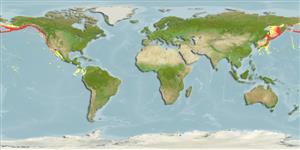Preferred temperature (Ref.
115969): 1.2 - 6.7, mean 3.8 (based on 417 cells).
Phylogenetic diversity index (Ref.
82804): PD
50 = 0.6250 [Uniqueness, from 0.5 = low to 2.0 = high].
Bayesian length-weight: a=0.00708 (0.00408 - 0.01228), b=3.16 (3.00 - 3.32), in cm Total Length, based on LWR estimates for this species & (Sub)family-body (Ref.
93245).
Nivel trófico (Ref.
69278): 3.6 ±0.3 se; based on diet studies.
Resiliencia (Ref.
120179): Muy bajo, población duplicada en un tiempo mínimo superior a 14 años (tmax> 100 (validated age: 62 yrs); tm= 13; Fec > 10,000).
Prior r = 0.03, 95% CL = 0.02 - 0.05, Based on 2 full stock assessments.
Fishing Vulnerability (Ref.
59153): High vulnerability (59 of 100).
Climate Vulnerability (Ref.
125649): Moderate vulnerability (38 of 100).
